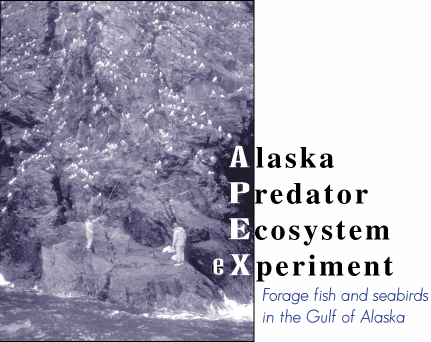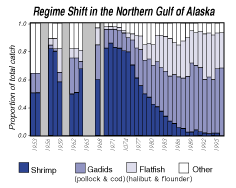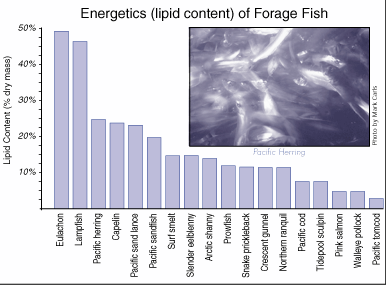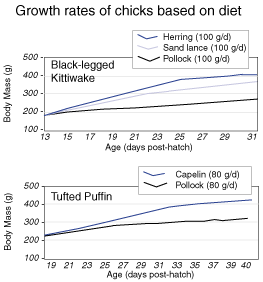
Common murres, black-legged kittiwakes, harbor seals, and Steller sea lions are examples of apex predators, fish eaters at or near the top of the food chain. Declines in these and other apex populations have occurred in the Gulf of Alaska since the 1970s. At the same time, the gulf has undergone a drastic change in the type and abundance of forage species, such as herring, capelin, sand lance, shrimp, young pollock and juvenile cod. The Alaska Predator Ecosystem Experiment (APEX) began in 1994 in an effort to determine why some seabird species injured by the oil spill showed no sign of recovery. Such knowledge was seen as essential to undertaking biologically realistic recovery. APEX asked the basic question: How does food availability - the type and abundance of forage fish- limit the ability of seabirds to recover from oil spill injuries?
A shift in the dominant forage fish populations occurred in the last half of the 1970s, likely triggered by a decadal shift in climate. Warming waters resulted in a shift from an ecosystem dominated by shrimp to one dominated by pollock and cod. Small-mesh trawl surveys, conducted annually since 1953, resulted in a strong database with nearly 10,000 individual sampling tows, collected over widely dispersed regions of the Gulf of Alaska. These data illustrate a massive change in the marine ecosystem, beginning in 1978. Shrimp and forage fish gave way to pollock and cod, and within two years there was a complete reversal in dominance (Figure 1).

The continuity of these surveys has allowed researchers to document a complete shift in the ecosystem in the late 1970s, probably due to a change in water temperature from around 2-degrees Centigrade to around 5-degrees Centigrade. Two decades later, Anderson is witnessing another potential shift. For two successive years, trawl surveys have shown that waters are again cooling and the population of cod and pollock has started to dwindle. Will shrimp again return to dominance in the Gulf of Alaska? Time will tell. Recent analysis of the 1996-1998 survey data has shown that the groundfish-dominant trophic structure still exists, but there are signs that the ecosystem may be shifting again. Beginning in 1999, water temperatures have fallen sharply in the North Pacific, suggesting that the spill area may be entering a period more favorable to the food fish on which injured seabirds depend.
Energetics
If ecosystem shifts force diet changes on seabirds, how does that affect egg production and survival of chicks? APEX researchers measured lipid or fat content of forage fishes because fat is the primary factor determining energy available to apex predators. Lipid content of seabird prey ranged from 5 percent of dry mass (Pacific tomcod) to 48 percent of dry mass (eulachon, also known as hooligan). Most of this variation occurred between species, but there were also variations within species related to age, sex, location, and the reproductive status of the fish.
Of the main fishes consumed by seabirds, juvenile herring, pre-spawning capelin, and sand lance had the highest energy content (Figure 2). Kittiwake diets were dominated by these high-lipid forage fishes at all study sites and such diets correlated with good nestling growth and survival. The trend in the 1990s of higher kittiwake productivity associated with increasing availability of sand lance, capelin, and herring was broken in 1997, a poor year at most kittiwake study colonies.

Controlled laboratory studies were conducted to better understand the nutritional difference between high-lipid and low-lipid fishes in the diets of kittiwakes. Kittiwakes fed a high proportion of sand lance and herring also had high growth rates and productivity (Figure 3). This compared to much lower growth rates and productivity in birds that consumed mostly demersal fishes (pollock) or gadids (cod). Juvenile kittiwakes required roughly twice the amount of pollock and cod to obtain the same growth rates as juveniles fed herring and sand lance.
These results support the hypothesis that nesting productivity of kittiwakes and guillemots in the Gulf region is strongly linked to the availability of three species of forage fishes: Pacific sand lance, Pacific herring, and capelin. These three species form schools near shore and have high energy densities compared with most other forage fishes. Recovery of seabird populations injured by the oil spill will likely depend, at least in part, on increases in these key fish stocks.
 Figure 3. The energetics of forage fish play an important role in the growth rate and survival of chicks. In a controlled experiment, black-legged kittiwake chicks fed herring and sand lance grew more than twice as fast as chicks fed the same amount of pollock. At the same time, tufted puffins fed fat-rich capelin doubled the growth rate of those fed pollock, a lean fish. A similar experiment conducted separately found that pigeon guillemots (not graphed here) had similar rates of growth, responding strongly to herring compared to pollock.
Figure 3. The energetics of forage fish play an important role in the growth rate and survival of chicks. In a controlled experiment, black-legged kittiwake chicks fed herring and sand lance grew more than twice as fast as chicks fed the same amount of pollock. At the same time, tufted puffins fed fat-rich capelin doubled the growth rate of those fed pollock, a lean fish. A similar experiment conducted separately found that pigeon guillemots (not graphed here) had similar rates of growth, responding strongly to herring compared to pollock.
Feeding behavior
By observing individual seabirds and schools of fishes, the APEX study has found several factors that influence how seabirds forage. In summer, the waters of Prince William Sound form layers with little mixing and the near-surface fish schools (herring, sand lance, and capelin) are small, occur in low densities, and are located close to shore. Seabirds in the sound respond by foraging singly or in small flocks close to shore. In contrast, in lower Cook Inlet, there is strong tidal mixing of the water column and the fish form larger and denser schools than in the sound, and the fish occur offshore (capelin and pollock) as well as nearshore (capelin and sand lance), so foraging flocks are larger.
APEX studies have found that when prey are predictable, seabirds learn and remember where prey can be found and individual birds return to the same area repeatedly, even if it means passing by fish schools. Individual kittiwake have been found to forage at the same stage of the tidal cycle on successive days at the same place, indicating that a high degree of "fine-tuning" to local conditions may be needed for successful foraging.
Halibut provide clues to forage fish availability
The availability of forage fish is both difficult to assess and expensive to measure. In an effort to find a cost-effective means of monitoring forage fish availability, the Trustee Council funded an experiment using halibut stomachs. Halibut sport-fishing guides were trained to collect stomachs from their daily catch and record when and where the halibut were caught. Stomach contents appear to correlate with the known locations of schools of forage fish, suggesting this is an expensive method for long-term monitoring.
Modeling
The population dynamics of kittiwakes and other seabirds show local variation within the northern Gulf of Alaska, even within an area such as the Gulf of Alaska. Some colonies, expanding, may produce young birds, that colonize new areas or cause old colonies to expand. We have modeled this by examining foraging and by examining both nesting success and adult energetic investment in raising young.
Summary
It appears that the APEX study took place when the northern Gulf of Alaska was in a warm phase that lasted for two decades, a time unfavorable for the capelin, herring and sand lance prey. These prey have high lipids and occur in schools, making them best as energy sources for reproducing seabirds. These fish did not vanish but retreated to cooler areas, closer to the Gulf itself while warmer areas were taken over by pollock and flatfish, unsuitable prey for many seabirds. Some seabirds, such as guillemots, were able to switch to solitary inshore prey, but birds like kittiwakes that need richer prey did poorly until the waters showed signs of cooling in the 1990's. With the recent apparent change to cooler conditions in the North Pacific, seabird populations may begin to recover, but their numbers need watching and we need to understand the new ecological conditions under which birds and prey interact, so we can determine the relative effects of human and natural forces as they interact on the Last Frontier.
